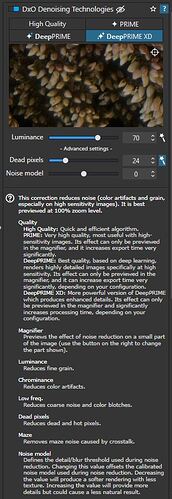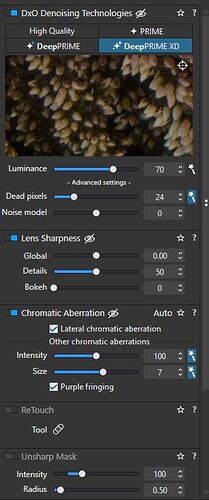Thanks for the heads up. I have some *ist D RAW files in my archives. The *ist D was my first DSLR. The lens selection was no great shakes and manual focus with my vintage Pentax lenses (K1000 shooter in film days) were impossible to focus back then. Cross-graded to a Canon 20D and stayed with Canon until 2019 when their cripple-hammer (particularly on video features) and the Nikon Z6 won me over.
I’m using Prime usually, the AI denoising often leads to plastic-looking images for me.
That is the first time I recall anyone saying that. Are you using the default settings, which are recommended? I completely disagree, but use whatever gives you the greatest satisfaction.
Mark
Default settings for noise reduction, just like all the other AI features (Smart Lighting, ClearView Plus) are set way too high.
That said, Prime was more susceptible to plasticky smoothing than DeepPrime. DeepPrime XD brings back the artefacts and strangeness at high settings.
@rwerp may have meant that he uses DeepPrime instead of DeepPrime XD, which would make sense. DeepPrime is the least artificial looking of the noise reduction choices, with HQ next or Prime heavily dialed down (think 2 or 4). DeepPrime XD has lots of potential for a plasticky look as it adds false detail and artificial texture (AI). The extra detail and texture can richen an image but if dialed up will look fake.
I generally also reduce the settings s bit when I use DeepPRIME, although not as much as you do based on discussions from quite a while ago.
My purpose in asking the question was to find out if @rwerp had perhaps modified the settings towards the high end of the range which would have given him unsatisfactory results. When it comes to all types of settings in post-processing, I know people who seem to believe that if a medium setting is good, a higher setting would somehow be better.
I agree that PRIME, not to mention HQ, is much more prone to looking plasticky when mis-applied. As I indicated in my response to him, I don’t recall anyone ever reporting results from DeepPRIME looking plasticky.
Mark
DeepPRIME XD each time when low light.
I personally use DeepPrime XD on every photo, unless there is a problem with a particular photo. ISO from base ISO to highest I use always DeepPrime XD, because it not only de noises but also does demosaicing and does excellent job.
Sometimes it can produce weird artifacts on people’s faces with high ISO values. Than I would tweak the sliders, especially Noise Level slider.
Also how much to set the default strength ( luminance slider) I think depends on the specific lens and camera combination. A medium format sensor with super sharp lens at base ISO probably will see a far less of a benefit than kit lens and APS-C or MF3 sensor. So best to find the sweet spot for gear you use and stick with it. I set it as default present upon import. That and other settings for color and all that.
Also results you are getting are very much dependent on other sliders such as lens sharpness, so its best to, again find the sweet spot for your gear and set it as preset for efficiency.
Here are my default settings for particular APS-C senor + fairly soft budget kit lens. Your mileage may very.
Hmm… I thought HQ would be the least modifying option to the images. Is that not the case?
Would you prefer DeepPrime over HD for an image not far away from base ISO (lets say ISO 200-1000)?
Well deepprime XD is mostly for detailed shots of subjects not for landscapes with details.
It actually replicate details which could be smutched by denoising to a extend of making up non excisting detail.
It’s better to have normal DeepPrime active. (older Primedenoise did created some artefacts, greyisch blocks, in some of the images wile deepprime keeps it clear and free of artefacts most of the time.)
HQ is that more back in time in denoising quality that it only usefull is for quick preview of the image for things as microcontrast and other things which are only applied in preview above 75% zoom.
As setting, default 40% of deepprime is often ok for m43 kind images til 1000 iso.
Above that is go slightly up. And 3200 iso i use 60% default by form of a partial preset which i apply after group selection. Above that i go manualy around 70-80%
Note deep prime isn’t liniair in strength so 60% isn’t twice the strenght of 30%.
Most of us here use HQ only on noisy non-raw images and never on raw images, and we also never use PRIME at all which only still exists for use by those who do not have a supported graphics card…
Instead, the majority of us use either DeepPRIME or DeepPRIME XD 100% of the time for every raw image, regardless of ISO, which is recommended by DxO based on how they designed these AI tools. Whether you use DeepPRIME or DeepPRIME XD, is completely up to you. DeepPRIME XD does provide a greater amount of very fine detail which some people find very useful on many images, but others do not care for the results.
As for myself, I use both depending on my goals for an image. If I heavily crop an image I will definitely use DeepPRIME XD, I have often used it other times as well. But, I use one or the other 100% of the time for my raw images.
Mark
I mostly use HQ, with only minimal corrections for color noise and hot pixels. I prefer to have my images not much altered and don’t care so much about a little noise, actually I mostly like it ![]()
Well, OK then. Since I upgraded to my M2Pro-Mac Mini, DeepPrime has become a valid option for every day use. I’ll give it a try as a standard procedure.
Thanks a lot
Matthias

